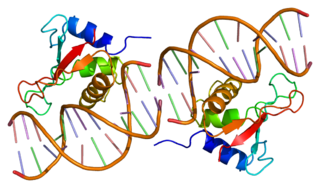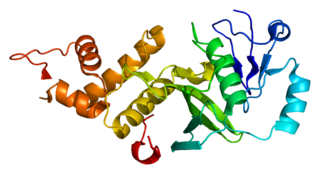P300/CBP-associated factor (PCAF), also known as K(lysine) acetyltransferase 2B (KAT2B), is a human gene and transcriptional coactivator associated with p53.
P300/CBP-associated factor (PCAF), also known as K(lysine) acetyltransferase 2B (KAT2B), is a human gene and transcriptional coactivator associated with p53.
Several domains of PCAF can act independently or in unison to enable its functions. PCAF has separate acetyltransferase and E3 ubiquitin ligase domains as well as a bromodomain for interaction with other proteins. PCAF also possesses sites for its own acetylation and ubiquitination. [5]
CBP and p300 are large nuclear proteins that bind to many sequence-specific factors involved in cell growth and/or differentiation, including c-jun and the adenoviral oncoprotein E1A. The protein encoded by the PCAF gene associates with p300/CBP. It has in vitro and in vivo binding activity with CBP and p300, and competes with E1A for binding sites in p300/CBP. It has histone acetyl transferase activity with core histones and nucleosome core particles, indicating that this protein plays a direct role in transcriptional regulation. [6]
The acetyltransferase activity and cellular location of PCAF are regulated through acetylation of PCAF itself. PCAF may be autoacetylated (acetylated by itself) or by p300. Acetylation leads to migration to the nucleus and enhances its acetyltransferase activity. [7] PCAF interacts with and is deacetylated by HDAC3, leading to a reduction in PCAF acetyltransferase activity and cytoplasmic localisation. [8]
PCAF forms complexes with numerous proteins that guide its activity. For example PCAF is recruited by ATF [9] to acetylate histones and promote transcription of ATF4 target genes.
There are various protein targets of PCAF's acetyltransferase activity including transcription factors such as Fli1, [10] p53 [11] and numerous histone residues. Hdm2, itself a ubiquitin ligase that targets p53, has also been demonstrated to be a target of the ubiquitin-ligase activity of PCAF. [5]
PCAF has been shown to interact with:

Histone acetyltransferases (HATs) are enzymes that acetylate conserved lysine amino acids on histone proteins by transferring an acetyl group from acetyl-CoA to form ε-N-acetyllysine. DNA is wrapped around histones, and, by transferring an acetyl group to the histones, genes can be turned on and off. In general, histone acetylation increases gene expression.

Histone acetyltransferase p300 also known as p300 HAT or E1A-associated protein p300 also known as EP300 or p300 is an enzyme that, in humans, is encoded by the EP300 gene. It functions as histone acetyltransferase that regulates transcription of genes via chromatin remodeling by allowing histone proteins to wrap DNA less tightly. This enzyme plays an essential role in regulating cell growth and division, prompting cells to mature and assume specialized functions (differentiate), and preventing the growth of cancerous tumors. The p300 protein appears to be critical for normal development before and after birth.
In molecular biology and genetics, transcription coregulators are proteins that interact with transcription factors to either activate or repress the transcription of specific genes. Transcription coregulators that activate gene transcription are referred to as coactivators while those that repress are known as corepressors. The mechanism of action of transcription coregulators is to modify chromatin structure and thereby make the associated DNA more or less accessible to transcription. In humans several dozen to several hundred coregulators are known, depending on the level of confidence with which the characterisation of a protein as a coregulator can be made. One class of transcription coregulators modifies chromatin structure through covalent modification of histones. A second ATP dependent class modifies the conformation of chromatin.

CREB-binding protein, also known as CREBBP or CBP or KAT3A, is a coactivator encoded by the CREBBP gene in humans, located on chromosome 16p13.3. CBP has intrinsic acetyltransferase functions; it is able to add acetyl groups to both transcription factors as well as histone lysines, the latter of which has been shown to alter chromatin structure making genes more accessible for transcription. This relatively unique acetyltransferase activity is also seen in another transcription enzyme, EP300 (p300). Together, they are known as the p300-CBP coactivator family and are known to associate with more than 16,000 genes in humans; however, while these proteins share many structural features, emerging evidence suggests that these two co-activators may promote transcription of genes with different biological functions.

The nuclear receptor coactivator 3 also known as NCOA3 is a protein that, in humans, is encoded by the NCOA3 gene. NCOA3 is also frequently called 'amplified in breast 1' (AIB1), steroid receptor coactivator-3 (SRC-3), or thyroid hormone receptor activator molecule 1 (TRAM-1).

Interferon regulatory factor 2 is a protein that in humans is encoded by the IRF2 gene.

Transformation/transcription domain-associated protein, also known as TRRAP, is a protein that in humans is encoded by the TRRAP gene. TRRAP belongs to the phosphatidylinositol 3-kinase-related kinase protein family.

Interferon regulatory factor 1 is a protein that in humans is encoded by the IRF1 gene.

Histone acetyltransferase KAT2A is an enzyme that in humans is encoded by the KAT2A gene.

Histone acetyltransferase KAT5 is an enzyme that in humans is encoded by the KAT5 gene. It is also commonly identified as TIP60.

TAF9 RNA polymerase II, TATA box binding protein (TBP)-associated factor, 32kDa, also known as TAF9, is a protein that in humans is encoded by the TAF9 gene.

Transcription initiation factor TFIID subunit 12 is a protein that in humans is encoded by the TAF12 gene.

Transcription initiation factor TFIID subunit 10 is a protein that in humans is encoded by the TAF10 gene.

Mediator of RNA polymerase II transcription subunit 21 is an enzyme that in humans is encoded by the MED21 gene.

K(lysine) acetyltransferase 6A (KAT6A), is an enzyme that, in humans, is encoded by the KAT6A gene. This gene is located on human chromosome 8, band 8p11.21.

Transcription initiation protein SPT3 homolog is a protein that in humans is encoded by the SUPT3H gene.

TAF5-like RNA polymerase II p300/CBP-associated factor-associated factor 65 kDa subunit 5L is an enzyme that in humans is encoded by the TAF5L gene.

TAF6-like RNA polymerase II p300/CBP-associated factor-associated factor 65 kDa subunit 6L is an enzyme that in humans is encoded by the TAF6L gene.

Biogenesis of lysosome-related organelles complex 1 subunit 1 is a protein that in humans is encoded by the BLOC1S1 gene.

In molecular biology, TAZ zinc finger domains are zinc-containing domains found in the homologous transcriptional co-activators CREB-binding protein (CBP) and the P300. CBP and P300 are histone acetyltransferases that catalyse the reversible acetylation of all four histones in nucleosomes, acting to regulate transcription via chromatin remodelling. These large nuclear proteins interact with numerous transcription factors and viral oncoproteins, including p53 tumour suppressor protein, E1A oncoprotein, MyoD, and GATA-1, and are involved in cell growth, differentiation and apoptosis. Both CBP and P300 have two copies of the TAZ domain, one in the N-terminal region, the other in the C-terminal region. The TAZ1 domain of CBP and P300 forms a complex with CITED2, inhibiting the activity of the hypoxia inducible factor (HIF-1alpha) and thereby attenuating the cellular response to low tissue oxygen concentration. Adaptation to hypoxia is mediated by transactivation of hypoxia-responsive genes by hypoxia-inducible factor-1 (HIF-1) in complex with the CBP and p300 transcriptional coactivators.
This article incorporates text from the United States National Library of Medicine, which is in the public domain.